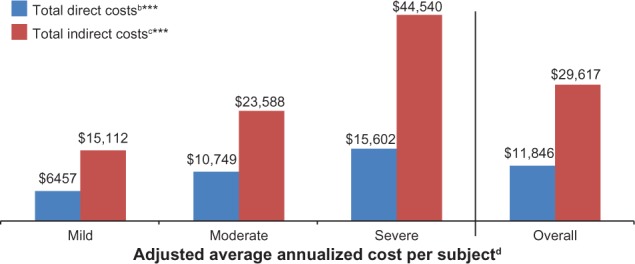Figure 10.

Adjusted average annualized cost per PTPS NeP subject, overall and by average pain severity.a
Notes: aScores on the BPI-SF Pain Severity were used to classify average pain severity as follows: 0–3 represents mild pain, 4–6 represents moderate pain, and 7–10 represents severe pain; baverage annualized total direct cost per subject was significantly different by pain severity (P < 0.0001). Direct costs include physician visits, other health care provider visits, prescription medications, TENS device, outpatient tests/procedures, emergency room visits, hospital outpatient visits, hospitalizations, direct medical costs to subjects, and direct nonmedical costs (child care, help with house and/or yard work, and help with activities of daily living) due to PTPS NeP. cAverage annualized total indirect cost per subject was significantly different by pain severity (P < 0.0001). Total indirect costs include overall work impairment, activity impairment, disability, unemployment, early retirement, and reduced work schedule due to PTPS NeP. dAdjusted LS mean estimates from multiple linear regression adjusted for confounding demographic and clinical variables – specifically, covariates for direct costs: ethnicity, pain severity (mild/moderate/severe only), prescription coverage, and comorbidities (headache/migraine, major depressive disorder, irritable bowel syndrome, cognitive dysfunction, chronic fatigue syndrome [overall only], sleep disturbance/insomnia, chronic low back pain, and other); and for indirect costs: age, race, pain severity, and comorbidities (major depressive disorder and irritable bowel syndrome).
Abbreviations: PTPS, post-traumatic/post-surgical; NeP, neuropathic pain; BPI-SF, Brief Pain Inventory-Short Form; TENS, transcutaneous electrical nerve stimulation; LS, least squares.
